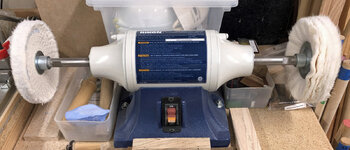I guess I am spoiled. I bought the PSI lathe mounted buffing system, the two-wheel system designed by Barry Gross, that comes with the blue buffing compound. But, I am just too impatient about changing my lathe between buffing and turning, so I bought a stand-alone Rikon Low Speed Long Shaft buffer for my shop.
It came with 8-inch by 1/2-inch wheels. With the buffer running at its 1750 RPM which calculates to about 3600 SFPM (Surface Feet/Feed Per Minute).
Since the PSI/Barry Gross system uses 4-inch wheels with a recommended top lathe speed of 1700 RPM, the easy solution would be to use 4-inch wheels on the 1750 RPM buffer; however, I found the choices for 4-inch wheels to be quite limited versus larger diameters. So I settled on 6-inch by 1-inch wheels which run around 2750 SFPM. So far it has been working very well for me even with running 1000 SFPM faster.
I use two wheels, the first is a tightly sewn cotton on which I apply the PSI blue compound. The second wheel is a loosely sewn flannel that I use as a final buff.
So far this arrangement has been working very well for me on both plastic blanks as well as CA finished blanks. Originally I used a mandrel and bushings to hold the blanks for buffing, but I do not like the grey metal rub-off from the mandrel and bushings that was contaminating my wheels. For a solution, I made a couple of tapered dowels with handles to use as tools to help hold the blanks. The taper fits tightly down into one end of the tube and I hold the other with my fingers - viola no more nasty grey on my buffing wheels.
Regardless of which buffing system you wind up with, I am sure you will like it. - Dave
View attachment 345040

